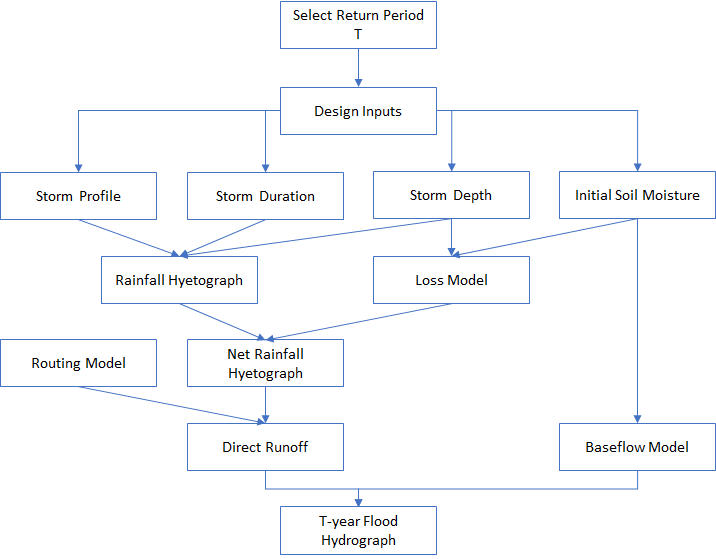Estimation of Design DDF Rainfall Hyetographs
Within the design package application, the rainfall depth-duration-frequency (DDF) model is used in conjunction with initial conditions and model parameters that have been estimated from catchment descriptors. These descriptors describe the physical attributes of the catchment such as area, soil properties, general wetness and degree of urbanisation application.
The rainfall inputs are derived using a FEH depth-duration-frequency rainfall model. The FEH22 rainfall model is the FEH’s latest UK-wide statistical model for rainfall DDF estimation. It supersedes the FEH13 model and the legacy FEH99 model.
ReFH2 translates this depth to both summer and winter hyetographs using the procedures described in this section. The application of the catchment design package is summarised as a flow diagram in Figure 5 with each step discussed in the following sections.

Figure 5. Steps in the calculation of the T-year design flood event. (Replicated from Figure 4.2 of the FEH Supplementary Report No1, Kjeldsen, 2007).
The ReFH2 design package was developed such that the rainfall depth for a given frequency will yield an event hydrograph for which the peak flow has the same frequency. Thus, a flood frequency curve can be constructed by estimating the peak flow corresponding to rainfall events covering a range of frequencies.
The FEH22 and FEH13 design package estimates of peak flow are independent of the FEH statistical methods (whereas the legacy FEH99 estimates were not). Furthermore, the performance of the method across many catchments and over a range of frequencies has been shown to be comparable to the FEH pooled statistical methods delivered through the WINFAP software. As most FEH applications tend to be in ungauged catchments where there are no observed flow records; the opportunity to use and compare two independent and comparable estimation procedures is a very useful tool for design.
In contrast the FEH99 design package requires an adjustment term to reconcile the frequency of the estimated hydrograph with the frequency of the design rainfall estimate. The adjustment is predicated upon the FEH statistical methods and hence the ReFH2 FEH99 estimates of peak flow are not independent of the FEH statistical methods. See ReFH2 Science Report: The ReFH2-FEH99 initial conditions and the alpha parameter^{R5} for further details.
The steps in estimating the storm hyetograph
The following sections describe the estimation of the storm hyetograph corresponding to a required frequency and a recommended storm duration. The purpose of these sections are to enable the reader to understand how the hyetographs are constructed and therefore only a summary of the methods are presented. These are described in detail in the underpinning literature base which is referenced for further reading. The recommended starting point for accessing the literature base is Section 4.3 of the FEH Supplementary Report No1 (Kjeldsen, 2007) noting that section 4.3.1 which describes the FEH99 DDF model has been made largely obsolete in the context of ReFH by the release of the FEH13 and subsequently FEH22. FEH Volume 2 (Faulkner, 1999) has a useful exploration of the seasonal storm profiles used within ReFH. Although written in 1999 there has been little work on FEH storm profiles since.
The steps are:
- Estimation of the recommended duration.
- Estimation of the depth for the required frequency, including choice of DDF rainfall model;
- Selection and application of an areal reduction factor to reflect that the DDF depth estimate is a point estimate and the corresponding average depth over a catchment will be lower than this;
- Selection of the storm seasonality and scaling of the rainfall depth to reflect that seasonality; and finally,
- The construction of the hyetograph for the target season using standard design profiles.
This estimation procedure relies heavily on the original estimation procedure published in the 1975 Flood Studies Report, although recommendations on rainfall models have evolved and the graphical method within the original procedures have been superseded by equations that approximate the original graphical methods. The original ReFH research also developed procedures for differentiating between summer and winter rainfall depths through the use of a correction term applied to the DDF model.